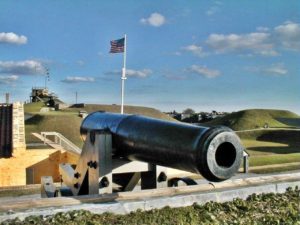People come to Charleston for many reasons – architecture, food, beaches and cultural events. Yet one of the main draws for Charleston is her incredible past. From Colonial times to the Civil War, this city by the sea played a prominent role in the country’s history.
The Charleston area has numerous museums and historical attractions that help tell the city’s many stories. It can be tough to see them all in one trip. For the best highlights, plan a visit to these homes, museums and attractions to learn all about Charleston, SC, history.
Top Historical Things to do in Charleston, SC
1) CHARLES TOWNE LANDING
To see where it all began, spend some time at Charles Towne Landing State Historic Site. This state park sits on a marshy point off the Ashley River on the spot where a group of English settlers landed in 1670 and established what would become the birthplace of the Carolina colony. Walk the self-guided history trail, explore the exhibits in the Visitor Center or visit the 22-acre natural habitat zoo to see a variety of animals that inhabited South Carolina at the time when this site was a newly settled English colony.
2) THE SOUTH CAROLINA HISTORICAL SOCIETY MUSEUM

The South Carolina Historical Society Museum is housed in a National Historic Landmark building at 100 Meeting St. The recently remodeled, repurposed Fireproof Building houses a new, state-of-the art museum with interactive exhibits that showcase South Carolina history, culture and arts. The building was designed by Robert Mills and constructed between 1822 and 1827. The Fireproof Building is believed to be the first of its kind constructed in the United States. Pairing personal manuscripts, maps, and artifacts with innovative technology, visitors experience illuminating moments that shaped Charleston, South Carolina and the country.
3) THE CHARLESTON MUSEUM
Founded in 1773 and commonly regarded as “America’s First Museum,” The Charleston Museum was established by the Charleston Library Society on the eve of the American Revolution. First opened to the public in 1824, the museum developed prominent collections. Operations were suspended due to the Civil War but began again shortly afterward.
Exhibits highlight the Native Americans who first inhabited the Lowcountry and enslaved African Americans who played a significant role in the area’s agricultural growth. Browse displays on historic textiles and clothing, Charleston silver and Charleston’s role in the Civil War. Young visitors can check out the kids’ area and family friendly activities.
WANT TO TOUR WHILE IN CHARLESTON?
If so, checkout TourPass Charleston which provides an all-access pass with full admission to over 40 top tours, attractions and historic sites. With a TourPass you can make reservations in advance, skip the lines and make your vacations a little more stress-free. Purchase online only at: https://tourpass.com/charleston
4) THE OLD EXCHANGE & PROVOST DUNGEON
According to historical accounts, petitions and arguments before the Assembly by Charles Town’s wealthy merchants and investors prompted the government to pass an act in 1767 for the building of an “Exchange or Custom House.” During 1771 and 1772, The Old Exchange and Provost Dungeon, with its Palladian symmetrical design, was constructed at the foot of Broad Street. It was renovated in the late 1970s and formally opened on Oct. 5, 1981. It remains a much-visited tourist attraction at 122 East Bay St.
5) FORT SUMTER
Easily visible in the center of the Charleston harbor, Fort Sumter National Monument is not only an interesting tourist attraction, but an important piece of American history. Confederate forces fired the first shots of the Civil War at Federal troops at Fort Sumter at 4:30 a.m. on April 12, 1861. Fort Sumter surrendered 34 hours later. Throughout the war’s duration, Fort Sumter would play an important role as Union forces spent nearly four years trying to take it back.
6) FORT MOULTRIE
Fort Moultrie on Sullivan’s Island has undergone numerous changes over the years. The first fort was still incomplete when Commodore Sir Peter Parker and nine warships attacked it on June 28, 1776. After a nine-hour battle, the ships retired. Charleston was saved fro
By 1809, a third brick fort was constructed on Sullivan’s Island. When South Carolina seceded from the Union in December 1860, the Federal garrison abandoned Fort Moultrie for the stronger Fort Sumter. By the 1880s, Fort Moultrie was modernized, but ultimately became a small part of the Fort Moultrie Military Reservation that covered much of the island.
7) EDMONDSTON-ALSTON HOUSE
The Edmondston-Alston House located at 21 East Battery was constructed in 1825. The views from its piazza are magnificent. In fact, Gen. P. T. Beauregard watched the bombardment of Fort Sumter on April 12, 1861, signaling the start of the Civil War. Later that year, on Dec. 11. Gen. Robert E. Lee stayed at the house when a large fire spread through his Charleston hotel.
8) OLD SLAVE MART MUSEUM

9) H.L. Hunley
On Feb. 17, 1864, the H. L. Hunley became the world’s first successful combat submarine when it sank the USS Housatonic. After signaling to shore that the mission was accomplished, the submarine and her crew of eight mysteriously vanished. Lost at sea for more than a century, the Hunley was located in 1995 by Clive Cussler’s National Underwater and Marine Agency. The vessel was raised in 2000 and delivered to the Warren Lasch Conservation Center in North Charleston, where scientists are working to preserve the Hunley for future generations.
10) MIDDLETON PLACE
A National Historic Landmark, Middleton Place is home to the oldest landscaped gardens in America. Visitors can walk through the extensive gardens and stop off at the Stableyards for a glimpse of life on an 18th– and 19th–century working plantation where skilled enslaved artisans made tools, pottery, clothing and tended an array of livestock.
The House Museum – built in 1755 – is a surviving portion of the three-building residential complex that once stood overlooking the Ashley River. Be sure to stop off at Eliza’s House, once occupied by former Middleton slaves. The house has historical exhibits and a list of the 2,800 enslaved people who worked on the Middleton’s various plantations around the Lowcountry.
11) NATHANIEL RUSSELL HOUSE MUSEUM
A National Historic Landmark, the Nathaniel Russell House Museum was built over a five-year period and completed in 1808 by Charleston merchant Nathaniel Russell. The house cost $80,000 to build, at a time when the average value of a home was $262. The home’s graceful, free-flying, three-story staircase is an architectural marvel with each cantilevered step supporting the one above and below it. The graceful interiors with elaborate plasterwork ornamentation, geometrically shaped rooms, formal gardens and collection of 18th-century decorative and fine art speak to the wealth of Charleston’s elite in the early days of the American Republic.

12) DRAYTON HALL PLANTATION
Founded in 1738, Drayton Hall is the nation’s earliest example of fully executed Palladian architecture and the oldest preserved plantation house in America still open to the public. Because of our preservation philosophy, all imperfections and changes over time have survived to the present.
13) CHARLESTON CITY MARKET
Explore Charleston City Market, one of the nation’s oldest public markets and the cultural heart of Charleston. It is home to more than 300 vibrant entrepreneurs, and we are open every day of the year except December 25th. No matter what time of day or season you plan to visit, there is something to see, do, taste, and take home as a souvenir from the Charleston City Market!
14) POWDER MAGAZINE
Completed in 1713, The Powder Magazine is South Carolina’s oldest government building. The building was used as an arsenal from 1713-1748 and during the American Revolution in order to defend the city. After 1780, it was retired, and by the early 19th century, it was privately owned. During this period, The Powder Magazine served as a print shop, livery stable, wine cellar, and carriage house. In 1902, The National Society of The Colonial Dames of America in The State of South Carolina purchased the building, saving it from demolition. Within a year, it was opened to the public. Today, it is a museum where you can explore colonial military history in the last standing component of Charleston’s original fortifications.

15) MCLEOD PLANTATION
Established in 1851, McLeod Plantation has borne witness to some of the most significant periods of Charleston’s – and our nations – history. Today McLeod Plantation is an important 37-acre Gullah/Geechee heritage site that has been carefully preserved in recognition of its cultural and historical significance. The grounds include a riverside outdoor pavilion, a sweeping oak alley, and the McLeod Oak, which is thought to be more than 600 years old.
To visit the majority of these top historical sites, purchase TourPass Charleston – top things to do in Charleston. With one pass you can visit up to 40 of Charleston’s top attractions.




